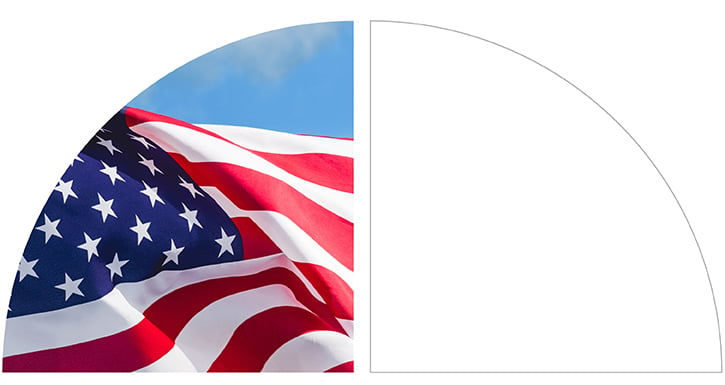Election Reflections
With postelection macro trends and the Republican agenda now in the forefront, Allspring’s fixed income teams highlight opportunities and risks for investors to consider in positioning portfolios.

Authors
11/11/2024
5 min read
Topic
Market Events
Key takeaways
- The U.S. election outcome broadly supports corporate credit given the likelihood of less regulation and a more favorable corporate and capital-gain tax regime.
- Pro-economic policy (tax cuts/less regulation), larger fiscal deficits, and tariffs are viewed as inflationary and will likely lead to modestly higher yields.
- Yield-advantaged sectors such as highly rated corporate, asset-backed, and mortgage-backed securities should continue to benefit short-duration portfolios.
- The potentially negative impact of far-reaching tariffs primarily focused on China presents a meaningful risk.
With the U.S. election uncertainty behind us, postelection macroeconomic trends and the Republican agenda are moving to the forefront. Higher interest rates, a stronger dollar, higher stocks, and tighter credit spreads reflect solid growth and normalizing inflation. However, economic and monetary policy uncertainty is rising. Below, our fixed income investment teams each highlight key opportunities and risks that fixed income investors should consider as portfolios are adjusted to position for the changing investment landscape.
Global liquidity
Expecting a lower policy rate
- We expect the Federal Reserve (Fed) to continue to cut its policy rate as the current level is overly restrictive to growth. One more rate cut is expected in 2024. Short-term interest rates are likely to fall, and the Treasury curve will likely steepen and normalize.
- If the Trump campaign’s preelection promises of tariffs, tax cuts, and stricter immigration policies are implemented, structurally higher deficits and inflation are likely to follow. In that scenario, additional rate cuts may be constrained and restrict further Fed easing.
- Yield-advantaged sectors such as highly rated corporate, asset-backed, and mortgage-backed securities should continue to benefit short-duration portfolios.
Core fixed income
Managing interest rate volatility in high-quality fixed income
- Interest rate volatility is likely to remain elevated following the election and into 2025. Policy uncertainty, heavy bond issuance, geopolitical risk, and macroeconomic data will all contribute to keeping interest rates volatile for the foreseeable future, particularly in the intermediate and longer end of the yield curve.
- Agency mortgage-backed securities are well positioned to perform in periods of high interest rate volatility. Limited credit risk and higher yield coupled with abundant security selection opportunities make the sector attractive.
- Tight credit spreads are warranted given the well-behaved macroeconomic situation and overall yield environment, but they look rich relative to securitized products, such as mortgage- and asset-backed securities. Nevertheless, solid fundamentals underpin current credit valuations. Looking forward, merger and acquisition risk may mount under the incoming administration if regulatory controls are eased.
Investment grade income
Generating income in investment-grade bonds
The recent U.S. election reinforces three central themes in investment-grade bonds.
- Pro-economic policy (tax cuts/less regulation), larger fiscal deficits, and tariffs are viewed as inflationary and will likely lead to modestly higher yields.
- A larger term premium at the long end of the yield curve and a steeper curve are a consequence of larger fiscal deficits.
- Credit spreads are likely to remain tight and may tighten further due to pro-economic policy.
Our theme of modestly higher rates was largely priced into the market leading up to the election. We ultimately think that rates in the intermediate part of the curve will move lower through the Fed’s rate-cutting cycle, and we view intermediate-duration rates as attractive in the current environment.
Plus fixed income
Janet Rilling, CFA
Jens Vanbrabant, CFA
Sarah Harrison
Pulling multiple levers to capture bond dislocations around the world
- The U.S. election outcome broadly supports corporate credit given the likelihood of less regulation (especially of financial and energy companies) and a more favorable corporate and capital-gain tax regime going forward.
- However, the potentially negative impact of far-reaching tariffs primarily focused on China presents a meaningful risk. Higher tariffs will likely increase input costs for some manufacturing and consumer sectors, and the consequential effect on inflation would be bearish for Treasuries.
- We also expect to see federal spending increase under the new administration, with defense as one area of focus. Higher federal spending would lead to higher deficits and contribute to the risk of higher inflation.
Our focus on a six-month outlook, use of multiple levers, and unbiased approach are more important than ever now, and they will be key to our navigation of policy dynamics and market conditions.
High yield & loans
European high yield and loans could benefit from the recent U.S. election as parts of Europe’s economy and businesses align with faster U.S. growth. However, President-elect Trump’s victory brings uncertainty both from trade and geopolitical views for Europe. With respect to transatlantic trade, an escalation of trade tensions would affect sectors of the economy most focused on exporting to the U.S., such as machinery and vehicles, manufacturing, and chemicals. Geopolitically, a lower level of support for Kyiv will very likely increase the odds of an end to the conflict on terms favorable to Russia. These two factors combined likely mean a slightly lower level of European economic growth, which would pressure companies with less financial flexibility and higher debt. Although our overall risk appetite is not negatively affected by the Republican victory, the hurdle will be higher going forward for investing in lower-rated companies or companies operating in sectors most exposed to the risk factors mentioned above.
Municipal fixed income
Capturing tax-advantaged income
- Our immediate post-election thought is income—more precisely, tax-advantaged income.
- Fixed income investors should be bullish on fixed income for the income—not the potential price appreciation. With yields close to year-to-date highs, there are numerous opportunities for fixed income investors to lock in attractive yields at above-inflationary rates. Municipal debt is well positioned to generate stable, durable, consistent income streams across the yield curve and up and down the rating spectrum.
- Key to performance will be inflation. Current yields are well above implied medium-term inflation rates and provide some cushion against sticky inflation. Positive real yields in munis allow investors to preserve—and improve—purchasing power over time, especially when adjusted for taxes.
Global fixed income
Going global
Investment grade
From a global perspective, the lack of a coherent plan to consolidate the historically pronounced U.S. federal deficit represents a significant risk to investment-grade fixed income. Furthermore, President-elect Trump’s preference for tariffs and trade wars should be viewed as inflationary and could push U.S. dollar yields higher over the coming months and years. This comes at a time when many other developed countries are also facing large deficits that will need to be funded at higher interest rates, bringing a renewed focus on debt sustainability. As a result, we prefer European rates over U.S. dollar rates.
Corporate issuers domiciled in the U.S., Scandinavia, and Southern Europe should benefit from favorable growth dynamics. However, political pressures in Germany, political and fiscal issues in France, and relatively tight corporate spreads in both countries keep us cautious on companies located in these countries. At a sector level, considering President-elect Trump’s stated preference for tariffs, we see continued headwinds for European automobile original equipment manufacturers, which are simultaneously struggling with lower demand for electric vehicles, pricing pressures from China, domestic labor issues, and more stringent European Union CO2 emissions caps starting in 2025. We remain underweight.





